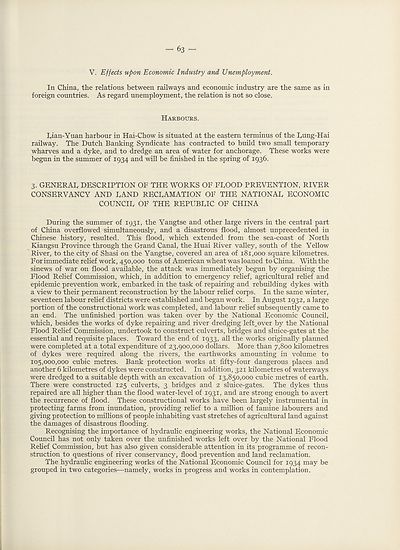Download files
Complete book:
Individual page:
Thumbnail gallery: Grid view | List view

— 63 —
V. Effects upon Economic Industry and Unemployment.
In China, the relations between railways and economic industry are the same as in
foreign countries. As regard unemployment, the relation is not so close.
Harbours.
hian-Yuan harbour in Hai-Chow is situated at the eastern terminus of the h-ung-Hai
railway. The Dutch Banking Syndicate has contracted to build two small temporary
wharves and a dyke, and to dredge an area of water for anchorage. These works were
begun in the summer of 1934 and will be finished in the spring of 1936.
3. GENERAL, DESCRIPTION OF THE WORKS OF FLOOD PREVENTION, RIVER
CONSERVANCY AND LAND RECLAMATION OF THE NATIONAL ECONOMIC
COUNCIL OF THE REPUBLIC OF CHINA
During the summer of 1931, the Yangtse and other large rivers in the central part
of China overflowed simultaneously, and a disastrous flood, almost unprecedented in
Chinese history, resulted. This flood, which extended from the sea-coast of North
Kiangsu Province through the Grand Canal, the Huai River valley, south of the Yellow
River, to the city of Shasi on the Yangtse, covered an area of 181,000 square kilometres.
For immediate relief work, 450,000 tons of American wheat was loaned to China. With the
sinews of war on flood available, the attack was immediately begun by organising the
Flood Relief Commission, which, in addition to emergency rehef, agricultural relief and
epidemic prevention work, embarked in the task of repairing and rebuilding dykes with
a view to their permanent reconstruction by the labour relief corps. In the same winter,
seventeen labour relief districts were established and began work. In August 1932, a large
portion of the constructional work was completed, and labour relief subsequently came to
an end. The unfinished portion was taken over by the National Economic Council,
which, besides the works of dyke repairing and river dredging leftover by the National
Flood Relief Commission, undertook to construct culverts, bridges and sluice-gates at the
essential and requisite places. Toward the end of 1933, all the works originally planned
were completed at a total expenditure of 23,900,000 dollars. More than 7,800 kilometres
of dykes were required along the rivers, the earthworks amounting in volume to
105,000,000 cubic metres. Bank protection works at fifty-four dangerous places and
another 6 kilometres of dykes were constructed. In addition, 321 kilometres of waterways
were dredged to a suitable depth with an excavation of 13,850,000 cubic metres of earth.
There were constructed 125 culverts, 3 bridges and 2 sluice-gates. The dykes thus
repaired are all higher than the flood water-level of 1931, and are strong enough to avert
the recurrence of flood. These constructional works have been largely instrumental in
protecting farms from inundation, providing relief to a million of famine labourers and
giving protection to millions of people inhabiting vast stretches of agricultural land against
the damages of disastrous flooding.
Recognising the importance of hydraulic engineering works, the National Economic
Council has not only taken over the unfinished works left over by the National Flood
Relief Commission, but has also given considerable attention in its programme of recon¬
struction to questions of river conservancy, flood prevention and land reclamation.
The hydraulic engineering works of the National Economic Council for 1934 may be
grouped in two categories—namely, works in progress and works in contemplation.
V. Effects upon Economic Industry and Unemployment.
In China, the relations between railways and economic industry are the same as in
foreign countries. As regard unemployment, the relation is not so close.
Harbours.
hian-Yuan harbour in Hai-Chow is situated at the eastern terminus of the h-ung-Hai
railway. The Dutch Banking Syndicate has contracted to build two small temporary
wharves and a dyke, and to dredge an area of water for anchorage. These works were
begun in the summer of 1934 and will be finished in the spring of 1936.
3. GENERAL, DESCRIPTION OF THE WORKS OF FLOOD PREVENTION, RIVER
CONSERVANCY AND LAND RECLAMATION OF THE NATIONAL ECONOMIC
COUNCIL OF THE REPUBLIC OF CHINA
During the summer of 1931, the Yangtse and other large rivers in the central part
of China overflowed simultaneously, and a disastrous flood, almost unprecedented in
Chinese history, resulted. This flood, which extended from the sea-coast of North
Kiangsu Province through the Grand Canal, the Huai River valley, south of the Yellow
River, to the city of Shasi on the Yangtse, covered an area of 181,000 square kilometres.
For immediate relief work, 450,000 tons of American wheat was loaned to China. With the
sinews of war on flood available, the attack was immediately begun by organising the
Flood Relief Commission, which, in addition to emergency rehef, agricultural relief and
epidemic prevention work, embarked in the task of repairing and rebuilding dykes with
a view to their permanent reconstruction by the labour relief corps. In the same winter,
seventeen labour relief districts were established and began work. In August 1932, a large
portion of the constructional work was completed, and labour relief subsequently came to
an end. The unfinished portion was taken over by the National Economic Council,
which, besides the works of dyke repairing and river dredging leftover by the National
Flood Relief Commission, undertook to construct culverts, bridges and sluice-gates at the
essential and requisite places. Toward the end of 1933, all the works originally planned
were completed at a total expenditure of 23,900,000 dollars. More than 7,800 kilometres
of dykes were required along the rivers, the earthworks amounting in volume to
105,000,000 cubic metres. Bank protection works at fifty-four dangerous places and
another 6 kilometres of dykes were constructed. In addition, 321 kilometres of waterways
were dredged to a suitable depth with an excavation of 13,850,000 cubic metres of earth.
There were constructed 125 culverts, 3 bridges and 2 sluice-gates. The dykes thus
repaired are all higher than the flood water-level of 1931, and are strong enough to avert
the recurrence of flood. These constructional works have been largely instrumental in
protecting farms from inundation, providing relief to a million of famine labourers and
giving protection to millions of people inhabiting vast stretches of agricultural land against
the damages of disastrous flooding.
Recognising the importance of hydraulic engineering works, the National Economic
Council has not only taken over the unfinished works left over by the National Flood
Relief Commission, but has also given considerable attention in its programme of recon¬
struction to questions of river conservancy, flood prevention and land reclamation.
The hydraulic engineering works of the National Economic Council for 1934 may be
grouped in two categories—namely, works in progress and works in contemplation.
Set display mode to:
![]() Universal Viewer |
Universal Viewer | ![]() Mirador |
Large image | Transcription
Mirador |
Large image | Transcription
Images and transcriptions on this page, including medium image downloads, may be used under the Creative Commons Attribution 4.0 International Licence unless otherwise stated. ![]()
| League of Nations > Communications and transit > Enquiry on national public works > (65) |
|---|
| Permanent URL | https://digital.nls.uk/194999195 |
|---|
| Shelfmark | LN.VIII |
|---|
| Description | Over 1,200 documents from the non-political organs of the League of Nations that dealt with health, disarmament, economic and financial matters for the duration of the League (1919-1945). Also online are statistical bulletins, essential facts, and an overview of the League by the first Secretary General, Sir Eric Drummond. These items are part of the Official Publications collection at the National Library of Scotland. |
|---|---|
| Additional NLS resources: |
|

